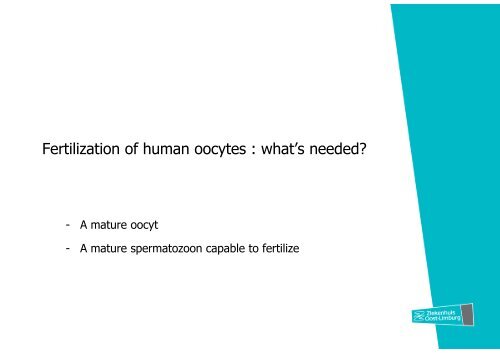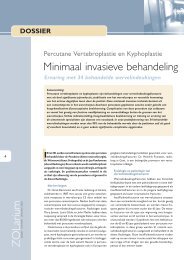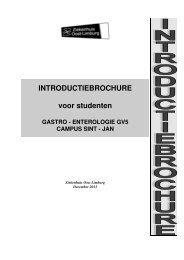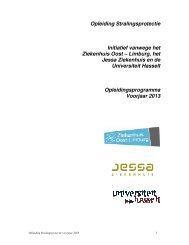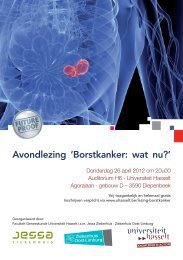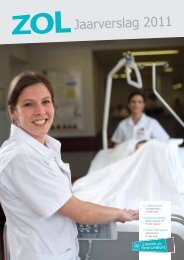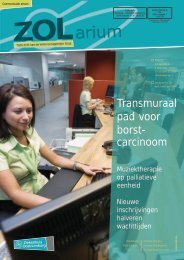Fertilization of human oocytes : what's needed?
Fertilization of human oocytes : what's needed?
Fertilization of human oocytes : what's needed?
Create successful ePaper yourself
Turn your PDF publications into a flip-book with our unique Google optimized e-Paper software.
<strong>Fertilization</strong> <strong>of</strong> <strong>human</strong> <strong>oocytes</strong> : what’s <strong>needed</strong>?- A mature oocyt- A mature spermatozoon capable to fertilize
Spermatozoa- In vivo spermatozoa attain their fertilizing capacity in the female tract= CAPACITATION ; in vitro this is done by gradient preparation , at 37°-39°C- Two properties : - hyperactive motility- change in surface membrane properties- Spermatozoa bind to receptors on the ZP- ZP induces morphological transformation <strong>of</strong> the spermatozoon : ACROSOMEREACTION : release <strong>of</strong> acrosomal content (enzymes)- Spermatozoon passes through ZP to the PVS : fusion <strong>of</strong> sperm plasma- andoocyt plasmamembranes- Ca+ waves in the oocyt : release <strong>of</strong> cortical granules > spermblock- Resumption <strong>of</strong> meiose : extrusion <strong>of</strong> second polar body, formation <strong>of</strong> femalepronucleus- Sperm nucleus decondendes, formation <strong>of</strong> male pronucleus and spindle- The oocyt is fertilized
Normal <strong>Fertilization</strong>pronucleinucleoli
Importance <strong>of</strong> scoring <strong>of</strong> fertilized <strong>oocytes</strong>?In ART success rates stay low :- < 30% <strong>of</strong> all embryos develop completely- Transfer <strong>of</strong> 2 – 6 embryos: higher success BUT multiple pregnancies- Extended culture to day 5: transfer <strong>of</strong> 1 to 2 embryossufficient , but only 40-50% <strong>of</strong> fertilized <strong>oocytes</strong> growto blastocysts and only 30-50% <strong>of</strong> the blastocysts implantTHUS: scoring <strong>of</strong> <strong>oocytes</strong> and fertilized <strong>oocytes</strong> (pronuclei) combined withembryo and blastocyst scoring, could help select the BEST embryo?
PN-score : scoring <strong>of</strong> the male and female pronucleus- contain the genetic material : parental chromosomes- indicator <strong>of</strong> both gamete quality and subsequent embryo implantationpotential- predictive value through correlations with chromosome constitution andincidence <strong>of</strong> zygotic arrest (Gianaroli et al.,2003; Balaban et al., 2004; ..)- other reports questioned predictive value (Nicoli et al., 2010; Weitzman etal., 2010)
PN-score : proposed scoring systems• Scott et al.,2000: Z1, Z2, Z3 and Z4• Tesarik & Greco (1999)• Ludwig et al : Scott + Tesarik
First step : Position, size and morphology <strong>of</strong> the nuclei16 – 18h after fertilization / insemination- juxtaposed: side by side- centrally positioned- approximately same sizeAberrant PN size and position correlates with developmental arrest, andaneuploidy, disruption in raster and microtubule formation (>4µm, far apartor peripherally, presence <strong>of</strong> fragmented or additional micronuclei (Munné and Cohen,1998) )
Nucleoli• <strong>human</strong> nucleus has 3 – 7 ; develop on the NucleolusOrganizingRegions <strong>of</strong>the chromosomes (coded for rDNA)• equal number in two daughter cells• nucleoli fuse during mitosis, but always synchrony in number and form• asynchrony : abnormal cells (cancer cells)• abnormal NOR morphology : fragmentation, aging →more dense bodies• involved in cell cycle control : growth regulating and mitogenic proteins• transcription <strong>of</strong> ribosomal genes• during oocyte maturation : RNA synthesis low : nucleoli small and scattered• at time <strong>of</strong> fertilization : rRNA synthesis high, nucleoli reform and grow
Second step :Scoring <strong>of</strong> nucleoli• 3 – 7/ nucleus, equal number, aligned• Not : pinpoints → delayed nuclear events, slow development : only10-15% reach blastocyst• Not : unequal → reduced developmental potential• Alignment or polarized distribution <strong>of</strong> chromatin is correlated withthe metabolic status and ability <strong>of</strong> the nuclei to fuse and form uniqueembryonic genome
Abnormal fertilization1 PN : 1% after IVF and ICSI : parthenogenetic (haploid) easy in ‘aged’<strong>oocytes</strong> or error in fertilization (diploid, but high risk <strong>of</strong> aneuploidy)3 PN: 1% after ICSI: failure in extrusion <strong>of</strong> second polar body; 5% in IVF
Cytoplasm : halo → high quality embryos, center is site withthe highest metabolic activity
Istanbul Consensus Workshop (2011)– 17 ± 1 h post insemination– Normal fertilization : 2 centrally, juxtaposed, equal in size nuclei,with equal number <strong>of</strong> nucleoli– Score :• Symmetrical : equal number and size <strong>of</strong> nucleoli, alignedor scaterred• Asymmetrical: all other patterns• Abnormal: single nucleoli or noneBut: Timing <strong>of</strong> assesment is critical, as pronuclear developmentis a dynamic process and zygote scoring should therefore beused with caution and only in conjunction with other methods<strong>of</strong> evaluation.
References• Essential Reproduction : Martin H. Johnson, 6th ed.• Textbook <strong>of</strong> Assisted Reproduction Techniques : Gardner, Weismann, Howles• Atlas <strong>of</strong> Human Gametes and Conceptus : L. Veeck• In Vitro <strong>Fertilization</strong> : Kay Elder and Brian Dale, 3th ed• Human Reproduction Vol 27 : Embryo Atlas


